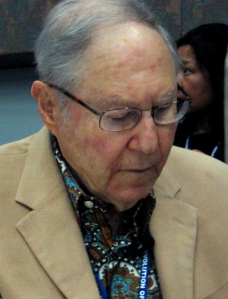Today would have been B.F. Skinner‘s 111th birthday. One of the first to apply the scientific method to psychology, Skinner built on the work of theorists like John B. Watson and Edward Thorndike to create a comprehensive explanation of behavior. His theory of operant conditioning states that behaviors that get rewarded tend to repeat themselves. This deceptively simple point is now the foundation for everything from business-management theory to weight-loss apps.
 When he retired from Harvard in 1974, no one would have predicted such dominance. Outside of psychology’s community, “therapy” was synonymous with “psychoanalysis” and his theories were seen as totalitarian mind control. About Behaviorism, published that year, was his parting shot; a comprehensive defense of his work for non-academic readers.
When he retired from Harvard in 1974, no one would have predicted such dominance. Outside of psychology’s community, “therapy” was synonymous with “psychoanalysis” and his theories were seen as totalitarian mind control. About Behaviorism, published that year, was his parting shot; a comprehensive defense of his work for non-academic readers.
He starts by discarding most of other theorists’ concerns. As he saw it, psychology has only one sensible question to ask: why do people behave the way they do? Inside that limit, there are only two reasons to inquire: either to predict someone’s behavior or to control it. An explanation like, “I went to a movie because I was in the mood,” is useless because we can’t predict when or why the mood might strike. An account based in operant conditioning, such as, “I went to a movie because I expected it would relieve feelings of boredom and reward me with feelings of being entertained,” tells us when someone might go (when they are bored) and how you might get them to go (bore them).
When he claims there are no such thing as ethics, motives, concepts or goals, Skinner sounds nihilistic. In fact, he believes in three things: behavior, reinforcers and rules. Rules are just summarized predictions of how behavior and reinforcers will work together, so they only half-count. He believed in reflexes and evolution too, but didn’t see them as being relevant to psychology. Although he denies purist black-box thinking, he relentlessly pares all that is human down to operant conditioning.
 On topics where his theories are best-validated, he writes with confidence, even benevolence towards his detractors. When he hits the edges of what behaviorism adequately explains, a detectable hint of snippiness leaks through. Knowledge? It’s a behavior of responses reinforced by others telling us we are right. Language? It’s a behavior reinforced by people responding the way we like when we speak. Creativity? It’s the behavior of experimenting with different combinations until something reinforcing emerges. Thought? It’s a behavior, too. Or anyway it’s the mental articulation of words, so it might as well be the same thing.What goes on in the brain? It doesn’t matter. Physiologists, he says with a sniff, will someday understand.
On topics where his theories are best-validated, he writes with confidence, even benevolence towards his detractors. When he hits the edges of what behaviorism adequately explains, a detectable hint of snippiness leaks through. Knowledge? It’s a behavior of responses reinforced by others telling us we are right. Language? It’s a behavior reinforced by people responding the way we like when we speak. Creativity? It’s the behavior of experimenting with different combinations until something reinforcing emerges. Thought? It’s a behavior, too. Or anyway it’s the mental articulation of words, so it might as well be the same thing.What goes on in the brain? It doesn’t matter. Physiologists, he says with a sniff, will someday understand.
That someday has come closer. Neuroimaging has revealed both insights into brain function and the limits of Skinner’s work. In considering his views, we have to consider our luxury of a viewpoint illuminated by MRI scans. All-encompassing theories hold a seductive allure that can infect our perceptions. Psych 101 students often develop “Freud-o-Scope”, a temporary disturbance that causes unresolved conflicts, todestrieb and phallic symbols to dominate the visual field. Most sufferers recover in a few weeks when the class moves on to operant conditioning. Given the confines of 1974’s technology, Skinner’s insistence that everything comes down to behavior and reinforcement is understandable.
When our cat reached old age, the vet recommended canned food to supplement the dry stuff. After fourteen years of kibble, pâté with Pacific salmon was so intoxicating, she ate until she vomited. I managed to wipe up only half of the mess before she came back, purring and sniffing. “Forget it, Java,” I told her. “You’ve had enough,” She cocked her head at the strangest angle and meowed – imploringly, it seemed – with sounds and cadences we’d never heard from her before. Skinner-Vision took effect. “Of course,” I thought. “She’s experimenting with new behaviors to see what will get reinforced with more canned food.”
@ 2015 Jonathan Miller All Rights Reserved














